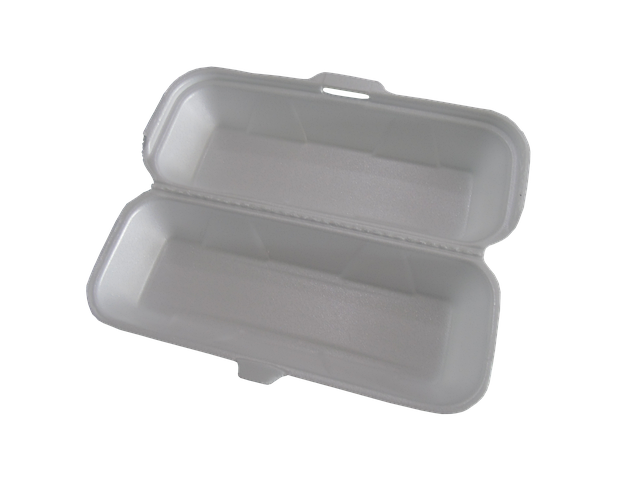Polystyrene is a versatile plastic material that can be used in various applications such as food packaging, toys, insulation materials, and more. On the other hand, Styrofoam is a trademarked brand of expanded polystyrene foam that is commonly used for insulation boards or disposable containers.
What is polystyrene?
(Photo By Ian Hughes on Flickr)

Polystyrene is a synthetic polymer made from the monomer styrene. It is a rigid, lightweight, and versatile plastic that can be molded into various shapes and sizes. Polystyrene has excellent insulating properties, making it ideal for use in the construction industry to create insulation panels.
Aside from its insulating properties, polystyrene also has good impact resistance and low water absorption rates. These qualities make it suitable for a range of applications such as packaging material, disposable cups and plates, CD cases, toys, and many more.
Polystyrene comes in two forms: solid (GPPS) or foamed (EPS). GPPS stands for General Purpose Polystyrene which is clear and brittle while EPS stands for Expanded Polystyrene foam which is white-colored with tiny air pockets throughout.
Polystyrene’s versatility makes it an essential material across several industries – including foodservice packaging- where these materials are used in takeout containers due to their ability to keep food hot/cold without melting or warping.
What is Styrofoam?
(Image by Aislan Máximo “Max” from Pixabay )

Styrofoam is a type of plastic material made from polystyrene, which is a petroleum-based thermoplastic polymer. It was first created by Dow Chemical Company in the 1940s and has since become widely used in various industries across the globe.
Styrofoam is known for its lightweight and excellent insulation properties, which make it ideal for use in packaging materials, disposable food containers, insulation panels, and even flotation devices. It comes in different forms such as sheets, blocks or beads.
Unfortunately Styrofoam takes hundreds of years to decompose and can have harmful effects on the environment if not properly disposed of. Due to this environmental impact many cities around the world have banned Styrofoam products.
Despite these concerns about its environmental impact, Styrofoam remains a popular choice due to its low cost production process and diverse applications.
Polystyrene Vs. Styrofoam – Key differences
Polystyrene can be transparent or opaque depending on how it’s made. It’s commonly used in packaging materials, disposable cutlery, CD cases, and insulation panels. On the other hand, Styrofoam is most recognized as the white lightweight material used for coffee cups or packing peanuts.
One of the main differences between these materials lies in their composition. Polystyrene comes in solid form whereas Styrofoam has been blown up with air pockets to create its signature texture. This means that polystyrene won’t break apart easily like foam does.
Another significant difference between them is their environmental impact. Traditional polystyrene products can take hundreds of years to decompose when not recycled properly while EPS (expanded polystyrene) from which Styrofoam is made of takes about 500 years to decompose contributing largely to pollution around us.
When it comes to cost-effectiveness – Styrofoam wins without any doubt over Polystyrene because of its light-weightiness and cheaper raw material resources making it much affordable than Polystyrene which requires more energy and resources during production processes.
Understanding the differences between polystyrene and Styrofoam can help you make informed decisions about what type of product may better suit your needs while being mindful of global concerns such as environment protection issues we face today
Uses of polystyrene
Polystyrene is a versatile plastic material that has a wide range of uses in various industries. One of the most common uses of polystyrene is for packaging materials such as disposable plates, cups, and food containers. Due to its lightweight nature and excellent insulation properties, it keeps food warm or cold during transport.
Polystyrene can also be used in construction for insulation panels to keep buildings energy-efficient. It’s an ideal material because it provides excellent thermal resistance while being easy to install.
Furthermore, polystyrene foam boards are commonly used as wall paneling or ceiling tiles in interior design projects due to their soundproofing qualities. The material absorbs noise and reduces echoes inside rooms making them perfect for recording studios and movie theaters.
In addition, Polystyrene is widely utilized by hobbyists who create models from scratch using this lightweight yet sturdy material. Its ability to hold intricate shapes after cutting makes it an ideal choice for architectural modeling.
Polystyrene’s unique characteristics make it suitable for use in various industrial applications ranging from automotive parts like dashboard components to electrical appliances like switchboards – demonstrating how useful this plastic really is!
Uses of Styrofoam
Styrofoam is a type of polystyrene foam that has become ubiquitous in our daily lives. It is used in a wide range of applications because it is lightweight, durable and insulating. One of the most common uses for Styrofoam is packaging material. Food containers, disposable cups and plates are also made from this material.
Styrofoam can be molded into various shapes making it ideal as insulation for buildings. It can also be used as soundproofing material due to its noise-absorbing properties. The buoyancy characteristic of Styrofoam makes it an excellent choice for use in flotation devices such as life jackets and buoys.
Crafters often use Styrofoam balls or blocks to create floral arrangements or other decorative items since they are easy to carve into different shapes without losing their form. Additionally, the insulation property of Styrofoam makes it useful in creating coolers for drinks and food which keeps them at optimal temperatures.
While Styrofoam has many practical uses, its disposability poses a significant environmental concern due to its non-biodegradable nature. However, recycling programs have been developed to reduce the amount sent to landfills annually while still benefiting from all these versatile uses that make our lives more comfortable and convenient every day!
What are the two types of polystyrene?
Polystyrene is a widely used plastic material that can be found in everyday items such as disposable cutlery, CD cases, and packaging materials. There are two main types of polystyrene: general-purpose polystyrene (GPPS) and high-impact polystyrene (HIPS).
GPPS is the most common type of polystyrene and is known for its transparency, rigidity, and low cost. It is often used to make food packaging, toys, and electronic components.
On the other hand, HIPS has better impact resistance than GPPS due to the addition of rubber or butadiene copolymers during manufacturing. This makes it ideal for applications where durability is required such as refrigerator liners or automotive parts.
Both types of polystyrene can also be recycled into new products which makes them environmentally friendly options for manufacturers looking to reduce their carbon footprint.
What is expanded polystyrene EPS foam?
Expanded polystyrene EPS foam, also known as Styrofoam, is a type of lightweight insulation material made from small beads of polystyrene that are fused together. The process begins by heating the raw material to form small plastic beads with a low density. These tiny grains contain 98% air and just 2% polymer.
Afterward, these beads are molded into various shapes using steam heat or an injection molding machine to create products like disposable cups, food containers, and packing materials. This versatile product can be found in almost every aspect of our daily lives due to its excellent insulating properties.
EPS foam has many advantages over other types of insulation such as being waterproof and resistant to moisture absorption. It is also energy-efficient and cost-effective for use in construction projects where it helps regulate indoor temperatures while reducing heating or cooling costs.
However, despite its popularity in the market today, expanded polystyrene EPS foam has faced some criticism regarding its environmental impact because it is not biodegradable and takes hundreds of years to decompose in landfills if not recycled properly.
How do you identify Styrofoam?
Identifying Styrofoam can be fairly easy once you know what to look for. Styrofoam is actually a brand name of expanded polystyrene foam, so any item made from this material can be referred to as Styrofoam.
One way to identify Styrofoam is by its texture. It has a rough, almost grainy feel that sets it apart from other types of plastic foam materials. It also tends to have a distinct squeaking sound when pressed or squeezed.
Another way to identify Styrofoam is by its color. It typically comes in a bright white hue, although it can also be found in other colors such as blue or green.
If you’re still unsure whether an item is made from Styrofoam or another type of plastic foam material, try looking for the recycling symbol on the item. If it’s labeled with the number 6 inside the chasing arrows symbol, then it’s likely made from polystyrene and could potentially be considered “Styrofoam”.
Remember that not all types of plastic foams are created equal, and some may even pose health risks if ingested or burned improperly. Always consult with your local waste management guidelines before disposing of any items made from polystyrene foam materials like Styrofoam.
Featured Image By – Brian Marco on Unsplash








